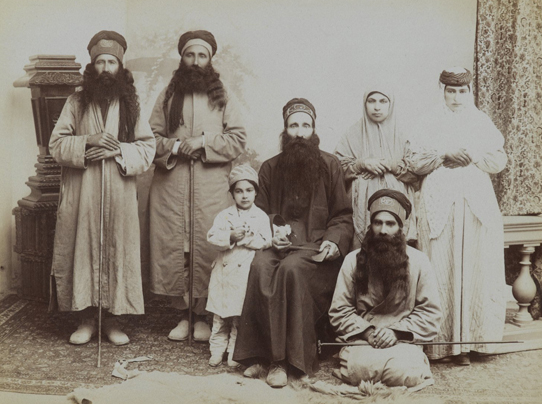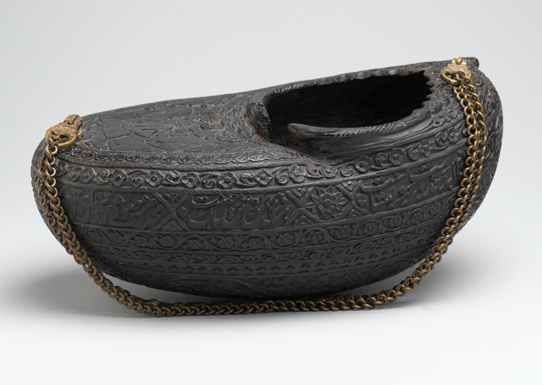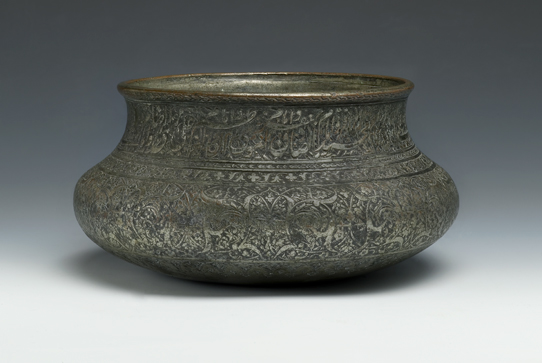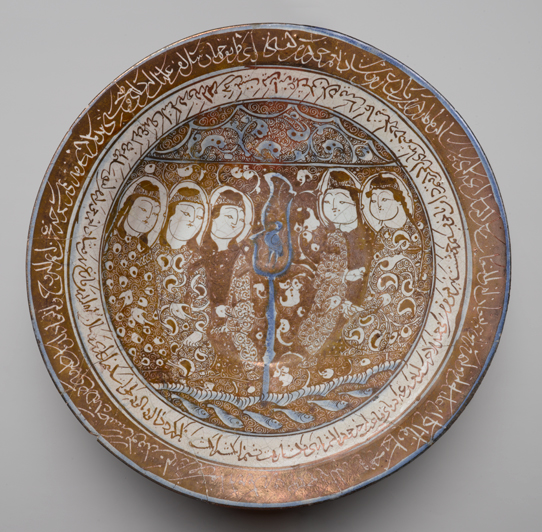
Sample of Persian Calligraphy from a Mughal Album. Calligraphy: Iran, Safavid, 16th century; margins: India, Mughal, 17th century. Ink, opaque watercolor, and gold on paper. Brooklyn Museum, Purchased with funds given by anonymous donors and the Helen Babbott Sanders Fund, 1991.185

Sample of Persian Calligraphy from a Mughal Album. Calligraphy: Iran, Safavid, 16th century; margins: India, Mughal, 17th century. Ink, opaque watercolor, and gold on paper. Brooklyn Museum, Purchased with funds given by anonymous donors and the Helen Babbott Sanders Fund, 1991.185

A Family of Dervishes. Possibly Antoin Sevruguin (Armenian-Georgian, 1830s–1933). Iran, late 19th–early 20th century. Silver albumen photograph. Brooklyn Museum, Purchase gift of Leona Soudavar in memory of Ahmad Soudavar, 1997.3.139
A Sufi’s attributes and clothing indicate the mystical order to which he or she belongs and may also suggest rank and status within that order. Here, the patriarch’s black robe emphasizes his authority. The varied styles of the hats further delineated positions within the group. The central seated figure holds a tabar, a small ceremonial axe, while each of the remaining men holds a walking staff, another iconic Sufi attribute. The extremely long beards of the male members identify this group as part of the Ahl-i Haqq order of Sufis, whose practices are guarded with extreme secrecy. The photograph may have been taken by Antoin Sevruguin, who served at the court of the Qajar ruler Nasir al-Din Shah in the latter nineteenth century and who is known for his portraits of Iranian landscapes and subjects.

Kashkūl, or Beggar’s Bowl, with Portrait of Dervishes and a Mounted Falconer. Iran, A.H. 1280/1880 C.E. Coco-de-mer shell and chain. Brooklyn Museum, Henry L. Batterman Fund, 47.203.5
Kashkūls carried the donations on which dervishes relied for sustenance and also functioned as drinking vessels or food containers for wandering ascetics. They simultaneously symbolized the emptying of the Sufi’s soul or ego through the renunciation of worldly goods and aspirations, and the nourishment of that soul with divine knowledge. Many kashkūls bear inscriptions invoking God, the house of the prophet Muhammad, or the twelve Shiʿa imams. The bowls were produced in a variety of media and were held or hung from the shoulder by metal chains. The earliest examples date to the thirteenth or fourteenth century, but their form may have been derived from crescent- and boat-shaped wine bowls made in pre-Islamic Iran. This example was made from the nutshell of the coco-de-mer palm native to islands of the Indian Ocean. The shells’ lengthy sea voyage to the shores of Iran carries special significance as a metaphor for the Sufi’s mystical journey. It includes a portrait of dervishes with tamed cats and two small kashkūls. Verses of Persian mystical poetry have been engraved into the rim:
Whoever has a pure soul as I do is welcome to the solitude of the dervishes; An example of virtue even tames animals; this is owing to the deeds of the dervishes; Whoever speaks of the radiance of the dervishes deserves the goblet of wine; I will be among the dervishes, for all eternity, away from eternal evil.

Wine Bowl Inscribed with the Names of the Twelve Shiʿa Imams. Iran, Safavid, late 16th–early 17th century. Copper; cast, raised, and turned, then tinned; engraved and inlaid with black composites. Brooklyn Museum, Gift of Mrs. Charles K. Wilkinson in memory of her husband, 1989.149.4
The Sufis consider wine liquid sunlight. Through its intoxicating properties, wine provides the mystic with an alternative reality in which he or she might catch a reflection of the divine and experience a form of ecstasy. The Persian poet Hafiz (1315–1390) also compared red wine to tears of blood resulting from the suffering of the soul estranged from the beloved. The form of this wine bowl appears to be a standard type among Iranian metal wares of the Safavid period (1501–1732). The inscriptions on such bowls, engraved in nastaʿlīq script, tend to be in Arabic, Persian, or a combination of the two, and are often laced with mystical references.

Bowl of Reflections. Iran, probably Kashan, early 13th century. Ceramic; fritware, painted in luster and blue over an opaque white glaze. Brooklyn Museum, Gift of the Ernest Erickson Foundation, Inc., 86.227.16
Beginning in the twelfth century, ceramics were produced in Iran with a frit body that provided a clean, light surface for painting. The most luxurious of these wares contained luster, added to the surface in a second firing and creating a metallic sheen that complemented mystical texts and images. While the image on this dish does not appear to be narrative, the presence of a bird, a familiar theme in Persian mystical literature, and certain human features associated with light (such as the figures’ moon-shaped faces) set the tone for the mystical verses appearing in two bands around the rim and interior. The text includes poetry by Rumi’s spiritual master, Shams al- Din Tabrizi (d. 1248), as well as verses believed to have been composed by the lesser-known Baba Afzal al-Din Kashani (d. 1213–14).
Light of the Sufis: The Mystical Arts of Islam
June 5–September 6, 2009
This installation features approximately twenty-five objects from the collections of the Brooklyn Museum, The Metropolitan Museum of Art, and private collections related to a mystical branch of Islam known as Sufism. While differing Muslim sects and diverse nationalities of the Islamic world may not always share a single religious or cultural ideology, the mystical and romantic aspects of Sufism tend to appeal to a global audience. Inspired by Sufi ideologies and the poetry of celebrated mystics such as al-Ghazzali (d. 1111) and Jalal al-Din Rumi (d. 1273), artists from the medieval Islamic period through the present day have produced works of art ranging from ceramic and metal wares to illustrated manuscripts and photographs. The theme of light and enlightenment is emphasized throughout, both literally and in its figurative or spiritual sense. Highlights include an extraordinary Egyptian gilded and enameled glass lamp inscribed with the famous “Light Verse” (Ayat al-Nūr) from the Qur’an; two brass candlesticks made in the Jazira region and Iran in the early thirteenth and sixteenth centuries, respectively; illustrated manuscripts, manuscript pages, and single folios of Sufi literature and subjects from Iran and India; an early thirteenth-century Iranian dish inscribed with mystical poetry; and a contemporary work on paper inspired by Sufi practices and produced with rubbings of prayer stones. Light of the Sufis at the Brooklyn Museum is presented in conjunction with Muslim Voices: Arts and Ideas, an unprecedented ten-day festival and conference in New York City in celebrating Islamic culture.
Light of the Sufis: The Mystical Arts of Islam is organized by Ladan Akbarnia, Hagop Kevorkian Associate Curator of Islamic Art, Brooklyn Museum.
The installation is supported by The Hagop Kevorkian Fund with additional support by Fred and Diana Elghanayan.